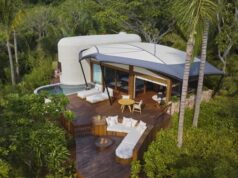 TETIAROA, FRENCH POLYNESIA—Located on the French Polynesian island of Tetiaroa and a product of the late Marlon Brando’s vision, construction on The Brando is progressing steadily with completion slated for late 2012. Pacific Beachcomber S.C. is developer of the resort. The president of French Polynesia, Gaston Tong Sang, recently made an official visit to Tetiaroa for a tour of The Brando construction site. Organized by Richard Bailey, CEO of Pacific Beachcomber S.C., and friend of the late actor, the trip was designed to share progress of the project’s construction with the president and his Minister of Environment, Jules Ienfa, as well as to underscore the facility’s potential for the region in the areas of tourism and employment, and as a regional showcase for best practices in sustainable development.
TETIAROA, FRENCH POLYNESIA—Located on the French Polynesian island of Tetiaroa and a product of the late Marlon Brando’s vision, construction on The Brando is progressing steadily with completion slated for late 2012. Pacific Beachcomber S.C. is developer of the resort. The president of French Polynesia, Gaston Tong Sang, recently made an official visit to Tetiaroa for a tour of The Brando construction site. Organized by Richard Bailey, CEO of Pacific Beachcomber S.C., and friend of the late actor, the trip was designed to share progress of the project’s construction with the president and his Minister of Environment, Jules Ienfa, as well as to underscore the facility’s potential for the region in the areas of tourism and employment, and as a regional showcase for best practices in sustainable development.
“President Tong Sang was impressed both by the progress of the project and by the overall concept for The Brando,” Bailey said. “He also expressed the positive impact the resort will bring to French Polynesia, creating jobs and adding an exciting new dimension to its tourism industry.”
Sustainability remains at the forefront of construction efforts and progress. Pacific Beachcomber remains committed to the goal of attaining LEED Platinum certification (Leadership in Energy and Environmental Design) from the U.S. Green Building Council (USGBC). Pacific Beachcomber hopes to make Tetiaroa a prototype for sustainable development in the hospitality industry.
Goal of Carbon Neutrality
In striving to achieve carbon neutrality, The Brando will produce as much energy as it consumes—or more. The two principal renewable technologies that will be used on the island include solar panels and bio-fuel generators. The photovoltaic (solar) panels will be installed alongside Pacific Beachcomber’s new airstrip, which was completed in May 2010. The balance of the energy demand will be sourced using bio-fuel.
A fundamental component of Tetiaroa’s goal of energy autonomy is the installation of a seawater air-conditioning (SWAC) system, which uses cold water pumped from 930 meters (nearly 3,000 feet) below the surface to cool the water used in the resort’s air-conditioning system. Given the year-round tropical climate in French Polynesia, air-conditioning can account for up to 50 percent of electricity consumption. SWAC significantly reduces the demand for electricity and will further Pacific Beachcomber’s goal of creating a 100 percent renewable energy community. This will be the second industrial SWAC system in the world; the first is located at the InterContinental Bora Bora Resort and Thalasso Spa, which is owned by Pacific Beachcomber. The Bora Bora system has saved approximately 2,500 tons of carbon dioxide per year since it was installed in 2006.
Additionally, plans for The Brando call for an innovative wastewater management system that would filter liquid wastewater into water usable for irrigation.
Landscaping efforts are well underway on the atoll. The master plan for Tetiaroa includes a substantial landscaping program aimed at caring for existing vegetation while also reintroducing various plant species on Onetahi (one of the islets, or motus, of Tetiaroa) that are native to the island, predating even the presence of the first Polynesian. Pacific Beachcomber intends to recreate the island’s original landscape, and nearly all plants that are currently being cultivated are already found on the motus of Tetiaroa. The landscaping program on Tetiaroa is a continual effort that will ultimately be incorporated into the ongoing management of Tetiaroa. Staff will be knowledgeable about the motus’ flora, and guests will be able to see and experience its natural beauty throughout the island.
New Nonprofit Created
Pacific Beachcomber also announced its participation as a founding member of the newly created nonprofit, “Tetiaroa Society.” Tetiaroa Society is dedicated to research, conservation and education related to the unique and delicate ecology of the island. The nonprofit’s goal is to create a scientific and educational window into the biodiversity of Tetiaroa, and raise public awareness regarding its fragile ecology. Tetiaroa Society is named after The Royal Society of London which financed James Cook’s first expedition to the islands. One of Captain Cook’s objectives on this voyage was to observe the transit of Venus. He made his observation from Tahiti and named that island group the “Society Islands” after the Royal Society.
Pacific Beachcomber is building a research facility on Tetiaroa that will be donated to Tetiaroa Society. In keeping with Marlon Brando’s wishes, students and scientists will have access to the facility for onsite research and education. In addition, another founding member of Tetiaroa Society, Brando Enterprises, which stands strongly behind Pacific Beachcomber’s project, has committed $100,000 in support of Tetiaroa Society’s conservation and educational activities.
In 2005, after conducting a great deal of due diligence, Brando Enterprises entered into an agreement with TBSA and Richard Bailey for the creation of The Brando on Tetiaroa. Today, Brando Enterprises continues to work closely with TBSA, Richard Bailey and the Brando Beneficiaries to ensure that The Brando is built according to Marlon’s original dreams for his island. Brando Enterprises is also actively involved in the overall management of Tetiaroa.
Go to Pacific Beachcomber.






